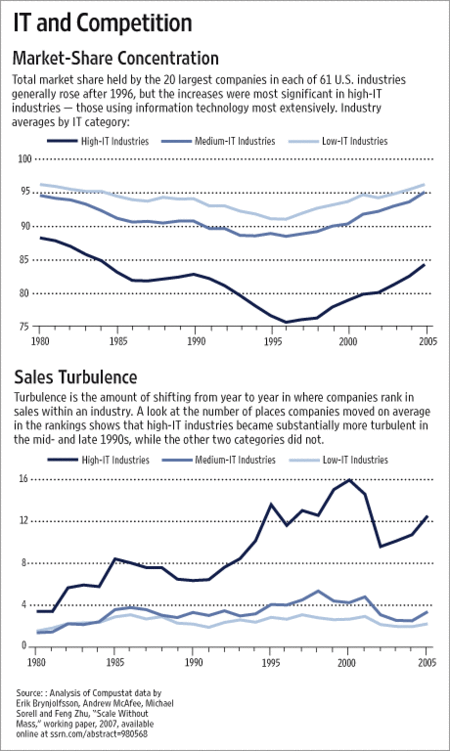 Source of graphic: online version of the WSJ article quoted and cited below.
Source of graphic: online version of the WSJ article quoted and cited below.
(p. R10) High-technology industries are tough places to do business.
Competition is constant, fierce and characterized by only temporary advantage, fueled by the ease with which software makers and other high-tech companies can copy and distribute new products and services.
Instantaneous delivery through the Internet to hundreds of millions of consumers means a company with a slightly better online marketplace or search engine, for example, can quickly dominate the market, and just as easily be dethroned by a rival with a new approach.
If this brutal competitive cycle — first described as "creative destruction" by Austrian economist Joseph Schumpeter in 1942 — makes you uncomfortable, we’ve got some bad news.
We’ve been studying competition in all U.S. industries, not just the high-tech ones, and we’ve observed a remarkable pattern: On average, the whole U.S. economy has become more "Schumpeterian" since the mid-1990s. What’s more, these changes have been greatest in the industries that buy the most software and computer hardware.
Over the past dozen years, in other words, information-technology consumption is associated with the kinds of competitive dynamics we’re accustomed to seeing in the IT-producing industries. And because every industry will become even more IT-intensive over the next decade, we expect competition to become even more Schumpeterian.
. . .
(p. R11) For executives, the key lesson is to treat information-technology efforts as opportunities to define and deploy new ways of working, rather than just projects to install, configure or integrate systems. Our work suggests three broad areas of focus for top managers:
– First, they need to look at how the company should be doing business differently. That means deciding what new tasks should be enabled with technology, and how widely they should be deployed.
– Second, managers need to lead the deployment of new procedures to success. People don’t like changes to their jobs dictated from outside and embedded in software. Overcoming this inertia and resistance requires skillful leadership.
– Third, managers need to foster innovation by encouraging experimentation, collaboration, dialogue and all of the other activities that generate good ideas. That means building a technology infrastructure and an accompanying set of practices that reduce the cost of creating and replicating process innovations.
Managers might not want competition in their industry to become more Schumpeterian, but they don’t have a choice. Companies are using IT to increase the speed of process innovation and replication. These companies drive the competitive dynamics of their industries, rather than reacting to them, leaving their rivals with a stark choice: Adopt the Schumpeterian ethos of creative destruction, or watch from the sidelines as others increasingly gain market share and value.
For the full story, see:
(Note: ellipsis added.)
